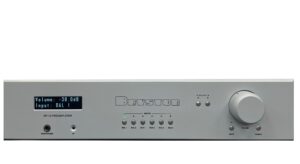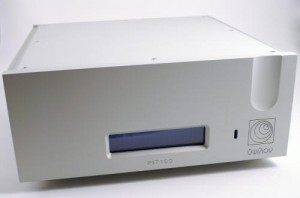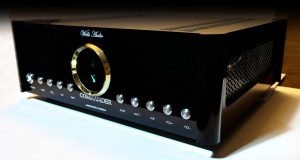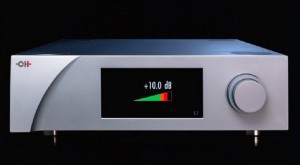
The pictures that accompany High Fidelity's review of the ASX-1000 amplifier show that it is a fairly large, not to say massive, unit. Short of putting the amplifier directly on the floor, I seated it on the Acoustic Revive RST-38H isolation boards. I needed two of them for a firm seating of the amplifier's feet.
In comparison, the ASX-2000 is even more massive. The '1000' was its little sibling, a development version operating in class AB and hence not requiring such large heat sinks. The "2000" is a no compromise design, a direct implementation of the ideas of Mr. Julian Studnicki, who holds a PhD in Physics and was an assistant professor at the Electronics Department of the AGH University of Science and Technology in Krakow, a designer, inventor and lecturer.
The machine, which I now had to seat directly on the floor (I would have needed four RST-38H boards under it), is an amplifier capable of delivering a whopping 80 Watts (into 8 Ohms) in pure class A, doubling it to 160 Watts at 4 Ohms. It weighs no less than 52 kg and measures 540 x 265 x 540 mm. Even the A-70 stereo power amplifier from Accuphase, one of the audio manufacturers I deeply respect, delivers "only" 60 watts per channel (at 8 Ohms) in Class A, weighs 44.3 kg and measures 465 x 238 x 514 mm. As a counterbalance, let me add that it boasts outstanding other parameters: a signal/noise ratio of 121dB, frequency range of 0.5 – 160,000Hz and damping factor of 1000, which is extremely high. The amplifier works reliable even driving loads as low as 1 Ohm, delivering 480 Watts per channel.
But I think that the real star of this review, with all due respect to the ASX-2000, is the ASP-1000 preamplifier. Its symbol indicates that formally belongs to the same series, which amplifier ASX-1000. I might as well be confused. He is the first preamp offer of the Krakow producer and perhaps the name has nothing to do with the "series".
If the preamplifier under today's review rings a bell with some of you, you are quite right: a special version of the higher model, the ASP-2000, marked with HF, was prepared by Abyssound for the 10/10 competition to celebrate the 10th anniversary of High Fidelity. Its proud winner became Mr. Artur Stański who now enjoys its presence in his audio system (see HERE).

Externally, the two components are remarkably alike, apart from a unique finish of the "competition" unit. The ASP-1000 is housed in a tank-like, low profile enclosure. The front panel is a thick piece of aluminum that features three knobs to control volume, select gain and mute mode and to switch inputs. The current state is indicated via different color LEDs.
The two Abyssound components were reviewed as a one complete system. It was compared to my reference system, i.e. the Ayon Audio Polaris III [Custom Version] tube preamplifier and the Soulution 710 solid-state power amplifier operating in class AB. But not only that, as during some of the auditions I swapped the Ayon for the Mark Levinson №52 preamp.
The signal was fed to the preamplifier via the Siltech Royal Signature Series Double Crown Empress RCA interconnects, and the preamp was hooked up to the power amp via the new Acoustic Revive PC-Triple C interconnects, also RCA. The preamplifier was seated on the Finite Elemente Pagode Edition rack and Franc Audio Accessories Ceramic Disc Original feet. I used the Harmonix X-DC350M2R-Improved Version power cord for the preamplifier, and the Acrolink Mexcel 7N-PC9300 for the power amplifier.

The preamplifier offers three levels of gain. This allows the user to adjust the gain of the whole system (preamp + power amp) to one's speakers, the size of their listening room and the distance of the listening spot from the speakers. The lower the gain, the lower the noise. Let me remind you that every additional meter away from the speakers means doubling the power output to maintain the same volume level. In my case, the gain setting of '-12dB' proved adequate.
SOUND
Albums auditioned during this review
• Ann Richards, Ann, Man!, ATCO/Warner Music Japan WPCR-25181, "Atlantic 60th", CD (1961/2007).
• Cyrus Chestnut, Midnight Melodies, Smoke Sessions Records SSR-1408, CD (2014); reviewed HERE.
• Dire Straits, Brothers in Arms, Vertigo/Universal Music Ltd. Hong Kong 5483572SX, SHM-XRCD2 (1985/2011).
• Fred Simon, Dreamhouse, Naim Label naimcd044, CD (2000).
• J. S. Bach, Goldberg Variations BWV 988. 1981 Digital Recording, Glen Gould (piano), CBS/Sony Music Entertainment Hong Kong 88765440092, "No. 0197", gold-CD (1982/2013).
• Jim Hall Trio, Blues On The Rocks, Gambit Records 69207, CD (2005).
• Kanaan, Duda, Rudź, Hołd, Solition SL 380-2, CD (2014); reviewed HERE.
• Martin Kratochvíl & Jazz Q, Temné Slunce, soundtrack, GAD Records GAD CD 018, CD (1980/2014).
• Niemen & Akwarele, Czy mnie jeszcze pamiętasz?, Polskie Nagrania MUZA/Polskie Nagrania, PNCD 1572, CD (1968/2014).
• Peter Gabriel, So. 25th Anniversary Deluxe Edition, Realworld/Virgin PGVOX2, 4 x CD + 2 x DVD + 180 g LP + 180 g, 45 rpm LP (1987/2012).
• Skrzek & Rudź, The Stratomusica Suite, Generator GEN CD 032, CD (2014); reviewed HERE.
I did not take too much auditioning of the Polish system to realize a few things. For one, the sound had a different character from the one I had heard from the ASX-1000 power amp. Two, it had nothing to do with the stereotypical perceptions of class A. And three, it was a true high-end. All three worked perfectly together.
It was the kind of sound where the most important is tonal differentiation. Just as with flagship Accuphase stereo power amps in class A, the A-65 and now the A-70, but also with class A components from Nelson Pass, the sound was very open and accurate. If some of you are looking for warmth and density, you should listen to the ASX-1000 (Abyssound), the P-6100 (Accuphase) or the Soulution 530 integrated. The both operate in class AB. Here, the sound opens up for a true spectacle of differentiation.

The noble class of amplifier's operation translated into a more accurate imaging, better tonal balance and much better interpenetration of various instruments, while maintaining their individual images and "ontogenetic" textures. The system seemed extremely resolving and selective at the same time – a good, if rare, combination. Even a very dense, complex mix, as that of Peter Gabriel's So remaster, got taken apart and put back together, but now with the more complete picture of what it's all about. I am breaking it up into two steps, although this division is artificial: the dismantling and putting it back together happens here at the same time. Suddenly, often unprepared, we are struck with the wealth of information, together with the overall structure of the song. Tentatively, we can assume it to be a wealth of detail. The system was certainly not short on detail, all the way from the bottom end to the highest treble. It was clearer and more open in the treble than my system with the Ayon and the Soulution. This method of presentation was closer to that of the Mark Levinson preamp paired with the Soulution power amp, even though the latter duo presented a slightly softer upper treble cymbals' attack. Not deciding which version was better—none of them is identical with the live music event and can only be its approximation—I have to admit that it was a clear vision and as such was easy to accept or reject.

It is worth emphasizing the excellent control the amplifier exercised over the speakers. The Harbeth M40.1, with its powerful 30-cm woofer, is not an easy load by any means. Although I often come across an opinion that it can be driven by low-powered tube amplifiers, the reality is much more nuanced. Indeed, if you find a tube amp with a good, "tight" power supply, if you do not play your music loud, and if you are fine with the lowest bass roll-off, then this may be a match for life. It was proved true by the TRX-M300 Reference Edition monoblocks from the Japanese Triode (see HERE). But you need to keep the limitations in mind. With higher output capable power amplifiers you get something more, especially in terms of more freedom and better control across the whole frequency range. It is of course easiest to notice in the bass department, but it really concerns the whole frequency range.
And it is an amplifier of the ASX-2000 kind that makes it clear what it's all about: everything you hear seems well ordered and revolves around the ultimate goal, which is showing as faithfully as possible what's on the CD disc (in the audio file).

And it doesn't really matter what kind of music you are listening to and what mood you are in. The system is very consistent and predictable in this respect; it will not cause an unpleasant surprise. With a golden edition of Goldberg Variations performed by Glenn Gould I heard a strong attack and extremely resonant sustain. The pianist's voice was clearly separate in the sense that it had been differently captured by the microphones, and thus belonged in a different acoustic "reality." It was a crystal-clear sound that Gould must have dreamed of and that this digital recording brings.
With Jim Hall Trio, or with Ann Richards accompanied by Barney Kessel on guitar, and finally with Józef Skrzek's and Przemysław Rudź's electronic instruments I could clearly hear the complexity of the production and how everything had been set in the mix by the sound engineer. Perfectly clear, and hence more understandable, were tonal differences between various elements of the presentation, as well as texture differences. It was as if some previously hidden, not fully exposed secrets suddenly saw the light of day. Both those simply interesting and those that the engineers and musicians would have preferred to remain silent. Like a slightly rumbling bass in Ann Richards's recordings, or the emphasized instruments' attack on Dire Straits album Brothers In Arms.

As always, so in this case, the key to success will be matching the system with your expectations and the rest of your audio system. This is not a universal amplifier (and speaking of "amplifier" I mean "system"). What I mean is that it has its own distinct character. Its sound is open and accurate, straightforward even. The bass is well controlled and hence rather contoured. The treble is open and strong, with no veiling. There are also things that are done differently somewhere else, like in my Soulution 710 or the Accuphase A-200, in the Triode monoblocks mentioned above or the Vitus Audio SS-101 power amp. The Abyssound shows a strong foreground with reduced sustain, which does not build up a very deep soundstage. That is why its sound is so striking and precise. But also more "upfront", as they remarked in Stereophile. There is also no such depth of sound, as in the above-mentioned components. Here, everything is happening right before our eyes.
And last but not least, the system is characterized by a slightly relaxed dynamics. This is probably the amplifier's aspect that is most difficult to define. The sound is tight, rhythmical and clear. But at the same time, what is most important in its presentation is the here and now, without going into the spatio-temporal relations.
Conclusion
It must have been a long time since I last heard such perfectly conveyed sound attack and so nicely controlled bass on my Harbeth speakers. A similar feat had been achieved by the massive Japanese A-200 monoblocks from Accuphase that I once auditioned for a review in the Polish Audio magazine. Tonal differentiation is outstanding as is sound attack, changing in all possible ways, especially in dense mixes. I cannot imagine any speakers that the Polish system could not drive with ease. Its open tonality and favoring the foreground might make one think about properly matching the rest of one's audio system, as there is little room for any errors, especially in terms of brightening or harshness. The amplifier will simply point it out and emphasize. If anything, it is better to combine it with something warmer and calmer. The Abyssound will handle it just perfectly. All in all, fantastic sound, outstanding performance and excellent mechanical design make for a well-deserved RED Fingerprint award.

DESIGN
ASP-1000
The preamplifier has a low profile enclosure and is very heavy. It is a solid-state design with an integrated power supply. The faceplate is made of a thick slab of aluminum, optically divided with milled out vertical lines. The center is defined by a large aluminum volume knob. It is attached to a motorized potentiometer. The knob features a milled line indicating its position. It is quite difficult to see, and disappears completely in the dark. If its position could be marked in a clearer way—with a LED or display screen—it would be perfect. Adjacent to it are two smaller knobs. One is used to change to set the preamplifier gain in two steps, -6 and -12dB, or to mute it completely. The third level, 0dB, is available via the remote control. To not go back to it later, let's say right now that the plastic remote looks rather ugly and is not particularly comfortable to operate. Such a good preamplifier, showing great design and solid workmanship, deserves something unique and handy at the same time. Each gain level and the mute mode is indicated with a different color LED. There are also LEDs around the other small knob that is used as an input selector. There are six inputs: one balanced XLR, four unbalanced RCA and a "Direct" input for an external processor, for example a Home Theater system.

The rear panel with its array of beautiful components makes one's heart beat faster. The RCA line inputs use excellent connectors with rhodium-plated contacts and Teflon dielectric, which look like WBT connectors. The XLR input is a classic Neutrik. There are three pairs of analog outputs: XLR (Neutrik), and two RCAs (which look like Cardas). Adjacent to them is a ground lift switch and trigger socket. The latter can be used to remotely (via cable) turn on and off an Abyssound power amplifier. There is also an antenna socket; to be honest I do not know what it is for.
The preamplifier's interior is tightly packed with circuit boards and components. For the most part, electronic components are mounted on several PCBs with golden traces, using classic through-hole assembly. All components involved in audio signal processing are mounted on daughter boards that are plugged into the motherboard. Input and output circuitry as well as left and right channels are kept separate—hence there are four daughter boards. Volume control uses a classic Alps Blue Velvet quadruple potentiometer. It thus appears that the preamplifier has a fully balanced design, from input to output. The potentiometer is mounted directly to the motherboard, between the two output channels and is coupled with a shaft to the front panel knob. It looks really great, the more so that the shaft features a Japan-made bearing.
The preamplifier employs a number of modules that look like Marantz HDAMs or NAD modules. I am referring to tiny circuit boards with surface mount components. These tiny PCBs are soldered to their corresponding circuit boards. They are coated with thick blue paint (or at least with what looks like paint), which makes it impossible to identify the individual components. That is the whole point, I think. What can be identified are large output MOSFETs that are mounted in pairs to small heat sinks. Each pair of output transistors works with six transistor drivers determining their quiescent point of operation. The output stage operates at high enough idle current to achieve maximum output signal amplitude also for low resistance loads of less than 600 Ohms.
The device operates on the basis of a patent called BQVA—bi-quartet voltage amplifier (voltage amplifier with a complementary quartet circuit). Strengthening the BQVA depends on the characteristic parameter of the system, the number of transistors external supply voltage gain controlled output BQVA systems and values of the two resistors (not working as usual in a negative feedback loop). One of them is the load resistor of the voltage amplifier. The other is transmitted (with virtually no loss) input voltage. Thanks to the ultra-linear amplifier preamp overvoltage moves very evenly all the band in the acoustic.
To input amplifiers BQVA system does not become overloaded by the large input signals, a system that allows the suppression of gain reduction of 6 dB or 12 dB. In the absence of damping strengthening ASP-1000 is 12dB or 18dB. With so-thought solution the maximum amplitude of the input voltage can be above 8 Vrms.
The preamplifier operates without a feedback loop. Not using a single operational amplifier in the signal path, which is built entirely based on discrete components.
Input signal selection is via relays. All of them are special low-level signal NAIS/Panasonic relays from the TX2SA series. Similar relays can also be seen on the gain stage circuit boards, and it appears that they are used to select the gain level. It is worth mentioning that after changing the gain level or selecting a different input, the signal is muted for a considerable time and comes back only after settling down of signal parameters. Passive components are of the highest quality and include Wima and Evox polypropylene capacitors, and Japanese electrolytic capacitors from Elna.
The power supply is mounted on a separate board. The circuit includes a small toroidal transformer, which supplies voltage that is rectified and filtered, and then stabilized in integrated circuits. The filtering circuit includes pretty-looking Nichicon capacitors. Behind the mains power socket there is a small Polish-made filter.
The power supply used in the ASP-1000 has a total of 30,000 μF filter capacitance. The use of specially designed filtering circuits and voltage controllers makes it possible to achieve negligible noise. Power to the analog circuits is supplied via 6N pure copper conductors. The PCBs used for both the analog section and auxiliary circuits feature assembly solutions used in professional applications, such as screw terminals instead of standard solder joints to use the effect of diffusion during assembly. This reduces the connector resistance and eliminates the additional silver-solder and solder-gold contact surfaces. The end result is coupling the connectors to the circuit board without using any solder.
ASX-2000
Power and authority—that is how I construe this amp. I had already described its enclosure design on the occasion of my ASX-1000 review, so let me just shortly repeat that it most closely resembles the style proposed and promoted by Pass Labs. The front panel only features the company logo and standby button backlit by a blue LED when powered. The rear panel does not overwhelm the user with abundance of connectors, either. It only sports a single pair of WBT speaker binding posts and a pair of RCA input connectors, also from WBT. Apparently the amplifier has an unbalanced design. The connectors are gold-plated.

The amplifier embodies all Mr. Studnicki's patents and design ideas. The basis is its operation in class A all the way up to its rated power output. Another important design principle is the lack of global negative feedback loop. The input stage sports the BQVA circuit, similar to that used in the preamplifier.
An original solution is also used in the DC servo circuit. It works using a high-voltage differential integrator. Since the integrator does not feed a DC offset control signal to the amplifier input (as happens in a commonly used solution), it results in no degradation of the audio signal.
The unit is powered by a huge 1000 W toroidal transformer placed right in the center. The filtering capacitor bank boasts a massive total capacity of 330,000 μF. The huge capacitors are bolted from the bottom to a metal plate. 100 mm2 and 200 mm2 silver plated copper flat bars are used instead of usual wire to minimize the connection resistance between various power supply components. Due to very high currents involved, a proper coupling to the ground and to the power line as well as to the speaker terminals is critical for the ASX-2000. For this purpose, internal wiring uses a very good quality 6N copper. All critical internal connections use robust screw terminals.

From the top you can see nice Jantzen Audio polypropylene capacitors, apparently parallel coupled with large bipolar electrolytic capacitors to improve the latter's characteristics.
The input stage employs the BQVA circuits similar to those used in the preamplifier—tiny boards with SMD components, painted in blue and soldered to a larger circuit board. The output transistors operating in push-pull (10 pairs) are bolted to solid aluminum components, and the latter are mounted to large heat sinks on both sides of the amplifier. The Abyssound heats up like hell and needs lots of space around it.
The amplifier includes a microprocessor to control its protection circuits and operating parameters. To minimize RF noise, care was taken for a proper galvanic isolation of the analog and digital sections. The ASX-2000 is the result of 10 years of research and testing.
Specification (according to the manufacturer)
ASP-1000
- Gain: 12 or 18 dB
- Frequency Response: 3 Hz - 375 kHz (-3 dB)
- S/N Ratio: 107 dB
- Input Voltage: 8 Vrms max
- Output Voltage 12 Vrms max
- Power Consumption:
- - During operation: 30 VA
- - In standby mode: < 3.5 VA
- Gain Setting: -6 dB and -12 dB
- Ground Lift Switch to disconnect the ground line from the chassis
- The "REMOTE ON" 12 V trigger port
- Zero negative feedback loop
- All circuits in the signal path operate in Class A
ASX-2000
-
Output Power RMS: 80W/8Ω | 160W/4Ω
-
Input Sensitivity RMS: 1.2 V
-
Gain: 29 dB
-
Frequency Response (1W/-3dB): 7 Hz - 80 kHz
-
THD: < 0.019%
-
S/N Ratio: 106 dB
-
Input Impedance: 10 kΩ
-
Mains Voltage: AC (50-60 Hz) 220-230 V
-
Power Consumption: 1200 VA (max)
-
Dimensions: 540 x 265 x 540 mm (W. X height. X D).
-
Weight: 52 kg
-
Manufacturer: Abyssound http://www.abyssound.com.pl </a>
-
Price (in Poland): 17 900 + 36 900 PLN
Abyssound | ul. Lipowa 3
30-702 Kraków | Poland
+ 48 695 290 600
[email protected]
www.Abyssound.com.pl
MADE IN POLAND
Text by Wojciech Pacuła
Images by Bartosz Łuczak/Piksel Studio | Wojciech Pacuła
Translation by Andrzej Dziadowiec







































